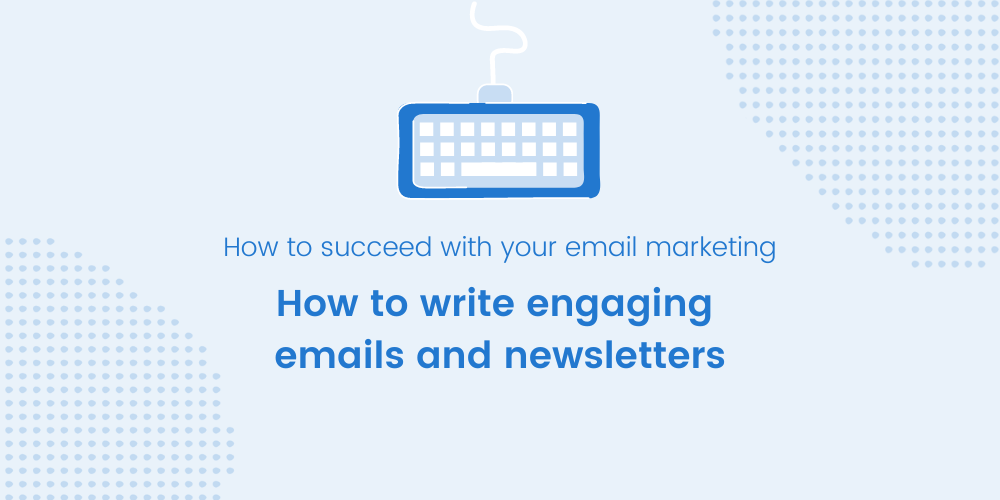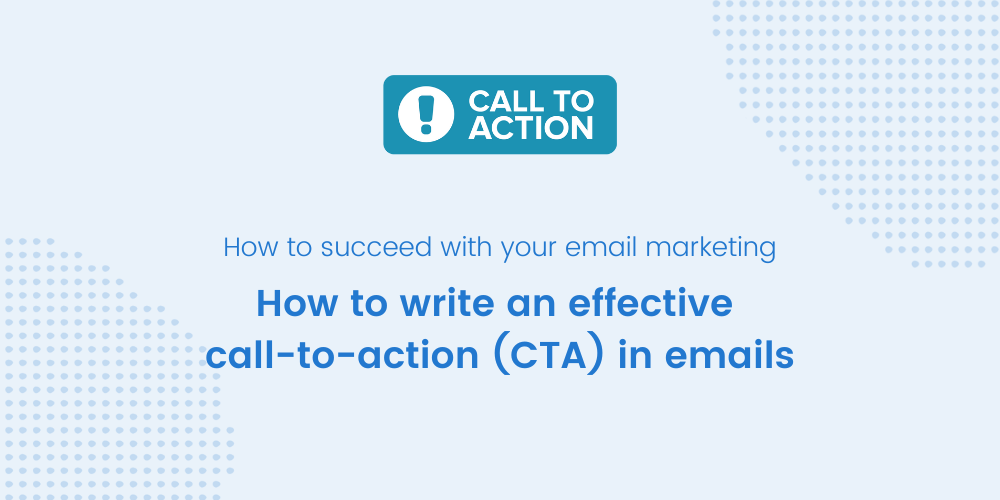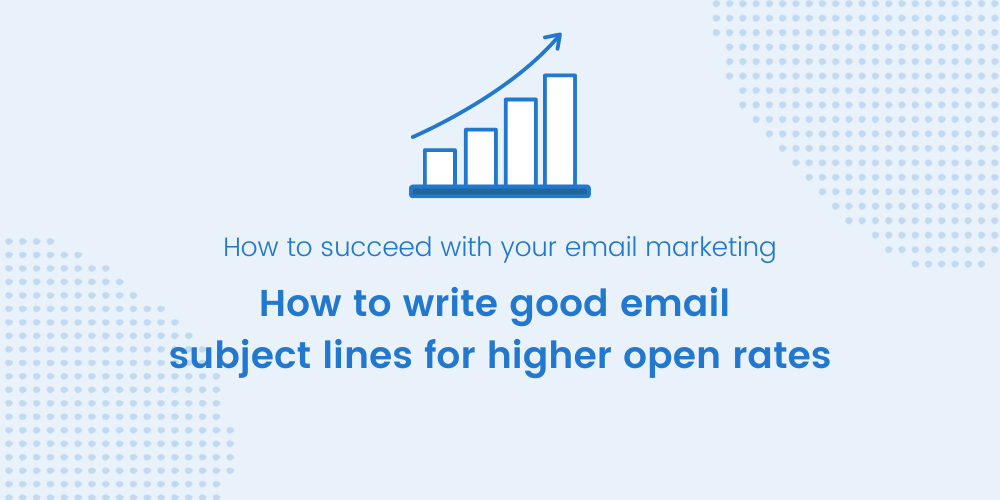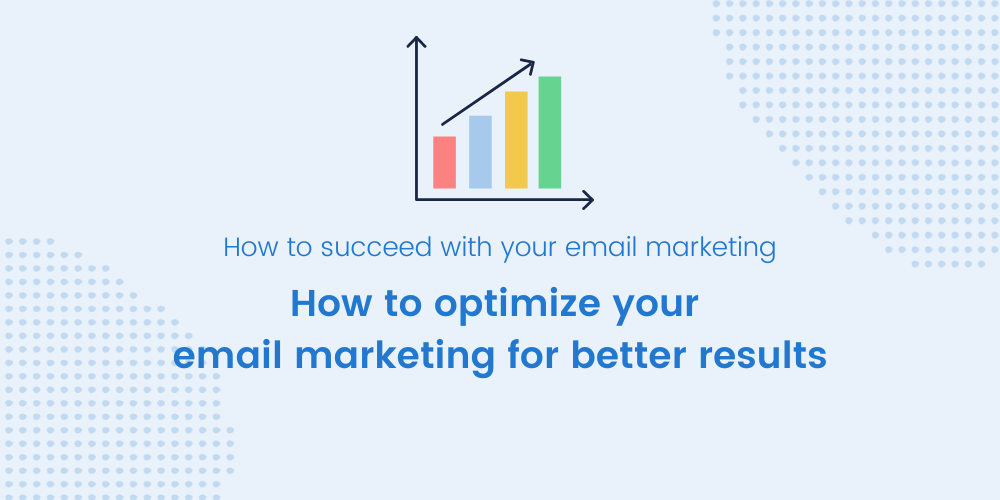How to write engaging emails and newsletters

You’ll find the answers to those questions in your undergraduate work. The work of understanding why exactly you should write newsletters, what your message is, who your readers are and what your goals are.
If you have a solid foundation to build on, you have the recipe for a successful newsletter that the recipient will read.
You can write excellent newsletters when you:
1. Have done the preparatory work
Before you start writing newsletters, you should have an email strategy. An email strategy based on your goals, and among other things, include what types of content you want to have in your emails.
Will you include blog posts, articles, videos, infographics, images, or customer stories? What do you think your target audience would be attracted to and appreciate?
Is it necessary your newsletter consists of overall self-produced content or should you also share other people’s content?
Finally, what kind of offers and company or product updates should you include – how often should they occur?
Email marketing is simple. But it’s not as simple as just starting to send out some offers and hoping for the best. The foundation of email marketing is relationship building. The relationship between you and the customer. Just like with any sale. First, you build the relationship, then you sell.
2. Know your audience
The key to building a relationship and making your newsletter feel personal, relevant, and amusing is to write as if you have a specific person in mind. Either a persona or someone you know who represents your target audience.
Here you can read more about the questions you need to ask yourself to develop a clear persona that can represent your target audience.
Knowing your audience is by far the most crucial step in writing a successful newsletter. Who are you writing to? What are their challenges, goals, and interests? What will motivate them to read your emails? What prior knowledge do they have about the subject you are writing about? This helps you guide what level you should set your sights on, and what word choices you make. Are they beginners or are they people who have already done some research?
Who are you writing to?
3. Understands the importance of clear goals and call-to-actions
A scattered newsletter without a clear objective is a newsletter that produces poorer results. Writing a newsletter with too many calls-to-actions is a newsletter that risks creating confusion. If you are confused, you lose.
We, humans, make an average of 70 choices every day. Too many choices tire the brain (so-called choice overload) and you risk losing the reader’s interest. If you want to get the reader to take action, click through to your website, download something or sign up for an event, you need to help them make quick decisions.
Ideally, you should be able to pick the main goal for your email and link a clear call-to-action (CTA) to that goal. It should be a no-brainer where you want the reader to click.
Then you can certainly include multiple links in your email, but your main CTA should stand out more than the others. That way, you show that the other links and buttons are for those who are particularly interested or “if-you-have-time-over” CTAs.
Nail down your goal and your main CTA before you start writing.
Obviously, there will be a difference if, for example, your newsletter aims to inspire only or to answer a variety of questions, as in a Q&A. In that case, the requirements for having clear CTAs are not as high, but in most cases where the goal is to sell and convert, you will benefit from being crystal clear.
Some things that characterize successful CTAs:
- They attract the eye immediately
- They stand out with color
- They have larger text than the body text
- They contain active words such as begin, start, get started, book, open, download
- They are written from a first-person perspective, such as “Book my place” instead of “Book your place” or “I want to download the checklist” instead of “Download the checklist here”
4. Learned to write newsletters with easy-to-understand texts
You’ll be doing your readers, and especially yourself, a big favor if you take that extra time to shorten and write more straightforwardly. So that the reader doesn’t have to try harder than necessary and can quickly absorb the message. Simplify for the reader.
For best readability, our tip is to think like you’re writing to a child or a young teenager.
- Write short sentences, aim for a maximum of 10-12 words
- Use simple words and avoid advanced jargon and professional terms
- Be comprehensible, write things out step by step
- Use bullet lists if possible
Another good reason to write concisely is that most people read their emails on their smartphones. And as you know, smartphones are teeming with distractions. It becomes all the more important to grab the reader’s attention immediately to ensure that the point of the email shows straight away.
Like journalists, keeping the “kill your darlings” mindset with you at all times is a winning strategy. Which is when you think the text is ready, read through and weed out any fluff that adds nothing of value to the purpose of the email. Instead, link to articles where the interested party can read more.
5. Focus on the subject line
The average open rate for newsletters is 22 %. If you write great and engaging subject lines, you can beat that. X % open an email just because of the subject line. With that in mind, getting recipients to open your email, it’s all about the subject line.
What should you put your focus on? Witch kind of subject line you should have depends on your situation and goals. Some general things that characterize a well-written subject line are the following:
- They are short and to the point – no more than 40-50 characters
- They avoid fluffy words and filler
- They don’t trick the reader into opening the email – they summarise the value of it
- They create a sense that what you have to say is urgent or very important
- They build a sense of FOMO (Fear Of Missing Out) – that the recipient does not want to miss this
- They arouse curiosity by not revealing the full answer
- They are personal
6. Put even more focus on the subject line
A generic subject line like “May Newsletter” or “Newsletter 3” is not preferable. It may tell you what it is, but it doesn’t say anything that will entice the reader to open it. Instead, write something related to the content that will pique interest.
An example of a subject line that arouses curiosity and does not reveal everything is “How to get more energy, all day long!”. Compare this with “Try micro naps – to get more energy!”.
The first summarises the value of reading the email. Who doesn’t want more energy? The second gives away the whole secret in the subject line and gives less reason to open the email.
Here are some ideas you can use as inspiration for your subject line:
- Ask a question – “Guess who won?”, “Where to start?”
- Copy one of the headlines in the email
- Include numbers – “9 things you didn’t know about…”, “5 steps to…”
- Start the subject line with an activating word such as book, see, listen, take part, get, download, win, join, max, try, don’t miss
- End the subject line with “…,it happened”
- Start the subject line with “Here is…”, “So…” or “Because…”
- Be secretive – “It’s not the first time”, “The success continues”
- Write one word – “Tomorrow!” or “New!”
- Include an appropriate emoji
7. Put at least as much effort into the preheader
The preheader, or the first line of your newsletter, acts as an extension of your subject line. If you use the subject line to entice opening, you can use the preheader to tempt further reading.
Even in the preheader, you need to be really brief. To be sure your preheader is visible in all email clients, keep it to 35-40 characters.
8. Use headings and subheadings
The headings in your email should guide the reader through the content, making it possible for them to find what interests them as quickly as possible.
40% of readers only scan the headings in an email.
Your readers will most likely only scan the content, not read every word. With that in mind, it’s crucial to use clear headlines. That way, the reader is more likely to find something of interest and take the time to read the full content.
9. Always start the newsletter with the most important information
In a dream world, all your readers would take their time to go through your newsletter word by word, text by text. The truth is, as previously stated, the vast majority scan the content.
The average click-through rate in emails is 3.5%. So, for example, if you ask a question in the subject line, it’s best to answer the question in the email, preferably as quickly as possible.
Although, as mentioned earlier, it is good to link to longer articles, the newsletter itself must be valuable in its own right. And that it answers any questions the reader may have when reading the subject line and the preheader. Otherwise, the reader will quickly get bored and your email risks being interpreted as clickbait. In the worst case, they may mark it as spam.
10. Gives that little extra
If you sell shoes – for example, tell the reader how to take care of their shoes, how others have styled them, and how they have been made.
If you have a hairdressing salon – share articles such as “how to style your hair for graduation”, “10 myths about shampoo” or “the whole list for eco-friendly hair care”.
Do you offer marketing services – share some free planning templates, and fillable PDFs, that will give your potential client a taste of how seamless it would be to work with you.
Are you following along? Putting extra effort and small details will make your readers fall in love with your newsletter, stay, open, click and convert into loyal customers. In this way, you provide value while smoothly telling a little bit about your company’s core values.
You want the reader to think:
“If the newsletter is this good, how good are their products/services?”
11. Keeping your promises
For your newsletter to be liked by your subscribers, it needs to be genuine and build trust.
Your reader gave you something valuable when they gave you their email address. They have done so in confidence, showing that they trust you not to abuse that trust.
The truth is that well-liked newsletters that deliver results over time deliver on their promises. They create expectations when you sign up and tell you what the newsletters will be about and how often they will land in your inbox. Then they deliver on their promises and show that the newsletters themselves are worth reading.
If the recipient trusts you (as a person or brand), they will open your emails.
So before you click send, you should always ask yourself – Does this newsletter deliver what I promised? If I received this email, would I appreciate it?
12. Blurring yourself out of the equation
Not to be harsh, your readers don’t care about you. They care about how you can help them, make their lives easier and solve their problems. Even more wonderfully, if you can even entertain them and put them in a better mood. If you make that a priority in your writing, your writing will be better.
Since your readers don’t care about you, it’s not a good idea to only talk about yourself and your business in your email, but there’s a caveat – storytelling works. It makes the email personal and strengthens the relationship with the person you’re writing to. Appearing human, vulnerable, and genuine is a great thing. So the words “I” and “we” are not a no-go zone, but before you start writing, you should think carefully about what the story adds. Does it add anything of value to your reader?
When it comes to talking about your products, services, and offers, the same applies. It’s not forbidden, of course. On the contrary, it is ultimately the whole point of your emails, to successfully sell more and convert readers into customers. But always start by asking yourself the question:
“How can I make this about the reader?”
You’ve heard it before, at least 80% of the email should contain something of value to the recipient, and 20% should be to asking for something and selling.
13. Writing as if to a friend
How do you express yourself when you write to a friend? For example, when you have discovered something you think the person will like. Most likely, you do so with lots of energy and vivid descriptions to show what you’ve found will give your friend.
You use the same language as your friend, choose relatable words, and bring up topics you know they’ll like. You use emojis where appropriate and share your own stories. Above all, you create a dialogue rather than a monologue. You use informal rather than formal language.
The reader is your friend. Write as if you expect a response back, and make sure you can get a reply by avoiding using a no-reply address.
14. Proofread your emails
Stop, pause, take a deep breath and read the text before you click send. It only takes a few extra minutes and could impact the final result for the better.
However, proofreading your texts can be difficult. If you have the time and opportunity, ask someone else to read your newsletters before you send them. Is it interesting enough, with unfinished sentences and spelling mistakes?
If you can’t, get someone else to help you, and then try reading your email out loud to yourself. Doing so will make it easier for you to spot mistakes and determine if your email is written in the right tone or if there are unnecessarily awkward phrases.
Over to you
Good luck with your writing! Now you know what you need to practice. Remember, if you can already check off 1 or 2 of the points above, you’re already well on your way to success with your newsletters.
Learn more about how to use Get a Newsletter to create and send newsletters for your email marketing.
In the next part of the guide, you’ll learn the art of measuring and analyzing your newsletters, so you can optimize your emails and constantly improve them.
Keep reading
Get started for free
Explore newsletters, landing pages, and surveys. Market your
products and services. Increase your sales and customer loyalty.


